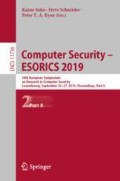Abstract
This paper proposes an id-eCK secure identity-based authenticated key exchange (ID-AKE) scheme, where the id-eCK security implies that a scheme resists against leakage of all combinations of master, static, and ephemeral secret keys except ones trivially break the security. Most existing id-eCK secure ID-AKE schemes require two symmetric pairing operations or a greater number of asymmetric pairing, which is faster than symmetric one, operations to establish a session key. However, our scheme is realized with a single asymmetric pairing operation for each party, and this is an advantage in efficiency.
The proposed scheme is based on the ID-AKE scheme by McCullagh and Barreto, which is vulnerable to an active attack. To achieve id-eCK security, we apply the HMQV construction and the NAXOS technique to the McCullagh–Barreto scheme. The id-eCK security is proved under the external Diffie–Hellman for target group assumption and the q-gap-bilinear collision attack assumption.
Access this chapter
Tax calculation will be finalised at checkout
Purchases are for personal use only
References
Barbulescu, R., Duquesne, S.: Updating key size estimations for pairings. Cryptology ePrint Archive, Report 2017/334 (2017)
Barreto, P.S.L.M., Naehrig, M.: Pairing-friendly elliptic curves of prime order. In: Preneel, B., Tavares, S. (eds.) SAC 2005. LNCS, vol. 3897, pp. 319–331. Springer, Heidelberg (2006). https://doi.org/10.1007/11693383_22
Bellare, M., Neven, G.: Multi-signatures in the plain public-key model and a general forking lemma. In: ACM CCS 2006, pp. 390–399. ACM Press (2006)
Bellare, M., Rogaway, P.: Entity authentication and key distribution. In: Stinson, D.R. (ed.) CRYPTO 1993. LNCS, vol. 773, pp. 232–249. Springer, Heidelberg (1994). https://doi.org/10.1007/3-540-48329-2_21
Boyd, C., Choo, K.-K.R.: Security of two-party identity-based key agreement. In: Dawson, E., Vaudenay, S. (eds.) Mycrypt 2005. LNCS, vol. 3715, pp. 229–243. Springer, Heidelberg (2005). https://doi.org/10.1007/11554868_17
Boyd, C., Cliff, Y., Gonzalez Nieto, J., Paterson, K.G.: Efficient one-round key exchange in the standard model. In: Mu, Y., Susilo, W., Seberry, J. (eds.) ACISP 2008. LNCS, vol. 5107, pp. 69–83. Springer, Heidelberg (2008). https://doi.org/10.1007/978-3-540-70500-0_6
Canetti, R., Krawczyk, H.: Analysis of key-exchange protocols and their use for building secure channels. In: Pfitzmann, B. (ed.) EUROCRYPT 2001. LNCS, vol. 2045, pp. 453–474. Springer, Heidelberg (2001). https://doi.org/10.1007/3-540-44987-6_28
Chen, L., Cheng, Z.: Security proof of Sakai-Kasahara’s identity-based encryption scheme. Cryptology ePrint Archive, Report 2005/226 (2005)
Chen, L., Cheng, Z., Smart, N.P.: Identity-based key agreement protocols from pairings. Int. J. Inf. Secur. 6(4), 213–241 (2007)
Cheng, Z., Chen, L.: On security proof of McCullagh-Barreto’s key agreement protocol and its variants. Cryptology ePrint Archive, Report 2005/201 (2005)
Choo, K.-K.R., Boyd, C., Hitchcock, Y.: Examining indistinguishability-based proof models for key establishment protocols. In: Roy, B. (ed.) ASIACRYPT 2005. LNCS, vol. 3788, pp. 585–604. Springer, Heidelberg (2005). https://doi.org/10.1007/11593447_32
Cremers, C.J.F.: Session-state Reveal is stronger than Ephemeral Key Reveal: attacking the NAXOS authenticated key exchange protocol. In: Abdalla, M., Pointcheval, D., Fouque, P.-A., Vergnaud, D. (eds.) ACNS 2009. LNCS, vol. 5536, pp. 20–33. Springer, Heidelberg (2009). https://doi.org/10.1007/978-3-642-01957-9_2
Cremers, C.J.F.: Examining indistinguishability-based security models for key exchange protocols: the case of CK, CK-HMQV, and eCK. In: ACM CCS 2011, pp. 80–91. ACM (2011)
Fiore, D., Gennaro, R.: Making the Diffie-Hellman protocol identity-based. In: Pieprzyk, J. (ed.) CT-RSA 2010. LNCS, vol. 5985, pp. 165–178. Springer, Heidelberg (2010). https://doi.org/10.1007/978-3-642-11925-5_12
Fujioka, A., Hoshino, F., Kobayashi, T., Suzuki, K., Ustaŏglu, B., Yoneyama, K.: id-eCK secure ID-based authenticated key exchange on symmetric and asymmetric pairing. IEICE Trans. Fundam. E96–A(6), 1139–1155 (2013)
Fujioka, A., Suzuki, K., Ustaoğlu, B.: Ephemeral key leakage resilient and efficient ID-AKEs that can share identities, private and master keys. In: Joye, M., Miyaji, A., Otsuka, A. (eds.) Pairing 2010. LNCS, vol. 6487, pp. 187–205. Springer, Heidelberg (2010). https://doi.org/10.1007/978-3-642-17455-1_12
Galbraith, S.D., Lin, X., Scott, M.: Endomorphisms for faster elliptic curve cryptography on a large class of curves. J. Cryptol. 24(3), 446–469 (2011)
Gallant, R.P., Lambert, R.J., Vanstone, S.A.: Faster point multiplication on elliptic curves with efficient endomorphisms. In: Kilian, J. (ed.) CRYPTO 2001. LNCS, vol. 2139, pp. 190–200. Springer, Heidelberg (2001). https://doi.org/10.1007/3-540-44647-8_11
Gartner Inc., Newsroom: Gartner Identifies Top 10 Strategic IoT Technologies and Trends. https://www.gartner.com/en/newsroom/press-releases/2018-11-07-gartner-identifies-top-10-strategic-iot-technologies-and-trends
Huang, H., Cao, Z.: An ID-based authenticated key exchange protocol based on bilinear Diffie-Hellman problem. In: ASIACCS 2009, pp. 333–342. ACM Press (2009)
Kim, T., Barbulescu, R.: Extended tower number field sieve: a new complexity for the medium prime case. In: Robshaw, M., Katz, J. (eds.) CRYPTO 2016. LNCS, vol. 9814, pp. 543–571. Springer, Heidelberg (2016). https://doi.org/10.1007/978-3-662-53018-4_20
Krawczyk, H.: HMQV: a high-performance secure Diffie-Hellman protocol. In: Shoup, V. (ed.) CRYPTO 2005. LNCS, vol. 3621, pp. 546–566. Springer, Heidelberg (2005). https://doi.org/10.1007/11535218_33
LaMacchia, B., Lauter, K., Mityagin, A.: Stronger security of authenticated key exchange. In: Susilo, W., Liu, J.K., Mu, Y. (eds.) ProvSec 2007. LNCS, vol. 4784, pp. 1–16. Springer, Heidelberg (2007). https://doi.org/10.1007/978-3-540-75670-5_1
McCullagh, N., Barreto, P.S.L.M.: A new two-party identity-based authenticated key agreement. In: Menezes, A. (ed.) CT-RSA 2005. LNCS, vol. 3376, pp. 262–274. Springer, Heidelberg (2005). https://doi.org/10.1007/978-3-540-30574-3_18
Okamoto, T., Pointcheval, D.: The gap-problems: a new class of problems for the security of cryptographic schemes. In: Kim, K. (ed.) PKC 2001. LNCS, vol. 1992, pp. 104–118. Springer, Heidelberg (2001). https://doi.org/10.1007/3-540-44586-2_8
Shamir, A.: Identity-based cryptosystems and signature schemes. In: Blakley, G.R., Chaum, D. (eds.) CRYPTO 1984. LNCS, vol. 196, pp. 47–53. Springer, Heidelberg (1985). https://doi.org/10.1007/3-540-39568-7_5
Vercauteren, F.: Optimal pairings. IEEE Trans. Inf. Theory 56, 455–461 (2010)
Author information
Authors and Affiliations
Corresponding author
Editor information
Editors and Affiliations
Rights and permissions
Copyright information
© 2019 Springer Nature Switzerland AG
About this paper
Cite this paper
Tomida, J., Fujioka, A., Nagai, A., Suzuki, K. (2019). Strongly Secure Identity-Based Key Exchange with Single Pairing Operation. In: Sako, K., Schneider, S., Ryan, P. (eds) Computer Security – ESORICS 2019. ESORICS 2019. Lecture Notes in Computer Science(), vol 11736. Springer, Cham. https://doi.org/10.1007/978-3-030-29962-0_23
Download citation
DOI: https://doi.org/10.1007/978-3-030-29962-0_23
Published:
Publisher Name: Springer, Cham
Print ISBN: 978-3-030-29961-3
Online ISBN: 978-3-030-29962-0
eBook Packages: Computer ScienceComputer Science (R0)

